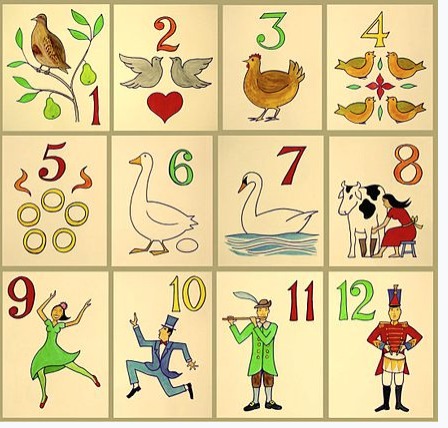My singing voice can best be described as, well, ‘mediocre’. Despite my mediocre voice and my Jewish identity (therefore not celebrating the Christmas Holiday in any way throughout my childhood), I simply adored singing all those wonderful holiday songs, especially Christmas carols throughout my childhood. I even recall caroling door to door with friends as a high school student, a practice that has surely diminished over time.

A 2013 Pew Study found that while 36% of adults recall going caroling as children, only 16% had gone caroling as adults. I realize this study is on the ‘old side’, but I haven’t heard about or seen carolers in quite some time.
WHY SINGING?
So why do folks love choral singing, especially Christmas songs? Well, they evoke memories of childhood and make us just feel good. According to Margaret Schaper, a USC professor of voice, “singing provides an emotional release…the human voice is the most perfect of all instruments.” Furthermore, Dr. Roderic Gorney, UCLA professor of psychiatry, states, “the impulse to sing might be more primitive than the impulse to speak,” noting the call of animals and the idea that babies have the ability to vocalize from the moment of birth over a wide range of pitches and of course, volume.
Well, back to singing the songs associated with the upcoming Holiday Season.
I want to focus on the appeal of the much beloved song, The 12 Days of Christmas.
12 DAYS AND WAYS TO FOSTER LANGUAGE AND LITERACY…USE THE SONG ITSELF!
Let’s start with the lyrics themselves and listen/look closely:

On the first day of Christmas, my true love gave to me:
A Partridge in a Pear Tree
2 Turtle Doves
3 French Hens
4 Calling Birds
5 Golden Rings
6 Geese a-Laying
7 Swans a-Swimming
8 Maids a-Milking
9 Ladies Dancing
10 Lords a-Leaping
11 Pipers Piping
12 Drummers Drumming
#1 Repetition
Children (and all of us really) love the repetition of all the verses of this song and many others. When singing this song, every time a verse is added, singers repeat the prior ones. This is so helpful to children’s language development–repetition is the very essence of how humans learn oral language.
#2 Alliteration
The repetition of the initial consonant sound(s)/phoneme(s) in order to provide emphasis. Do note alliteration occurs throughout the holiday song, as well as the big time alliteration of the old favorite Peter Piper:

A partridge in a pear tree
7 swans a swimming
8 maids a milking
10 lords a leaping
11 pipers piping
12 drummers drumming
The alliteration helps children attend to the individual sounds/phonemes of language, which helps them develop early literacy skills (this is known as ‘phonological awareness’). Phonological Awareness is highly correlated to the development of early reading/spelling skills.
#3 Counting Skills.

Children need to develop not only language literacy, but both cardinal and ordinal numeric literacy skills as well. Obviously, the lyrics include counting ordinally forward and backward from 1 (in this song, 1 is denoted by the indefinite article “a” as in “a partridge in a pear tree) to 12. In addition, children have exposure to cardinal numbers from 1st, 2nd, 3rd….12th when hearing/singing the song.
#4 Vocabulary Building/Morphology
Are your children/students familiar with the many vocabulary words included in this song?

It’s a good time to give vocabulary building more thought and discussion time during get-togethers with family and friends. Some of these words, while uncommon, are still included in the song and deserve discussion (some more than others).
And do not forget to talk about the meaning parts of words, otherwise known as morphology including:
- Suffix -s to denote plural–and note that all the plural suffixes are pronounced with the voiced /z/ sound in this song (unlike words such as ‘cups’, ‘forks’, where the -s is pronounced with the unvoiced /s/ sound.
- Suffix -ing to denote the continuing over time (progressive) verb tense as in ‘maids a milking’, ‘swans a swimming’, etc. The phraseology of ‘a’ swimming’, ‘a’milking’, etc. provides for 4 syllables in each phrase throughout the song, just in case you/your kids were wondering.
#5 Overall Language Development/Categorization
This goes hand in hand with new vocabulary learning. Do note the emphasis on the categories of birds, musical instruments, and people performing actions:
- Birds: partridge, hen, geese, calling bird, dove, swan
- Musical instruments: pipers piping (pipe), drummers drumming (drum)
- Actions: swimming, milking, leaping, dancing, laying, piping, drumming
Good takeoffs to extend learning include:
- Having kids name as many different types of birds as they can with extensions to where these birds are found, their uses, etc.
- Having kids name as many different instruments as they can with extensions to categorizing them as brass, woodwinds, percussion, etc.
- Having kids practice inference making skills such as: Where and when do you think this song is occurring and why? (see my final section below for more information to share)
#6 Choral Practice/Prosody→this leads to improvements in Oral Language Fluency→this leads to the development and improvement in Reading Fluency

When the same verses are sung together as a group repeatedly, the result will be an increase in phrasing of words which are grouped together for meaning, as well as singing with expression–this is known as prosody. Working on prosody through singing will, in turn, help children develop oral language expression, which will lead to the development of reading fluency.
#7 Increase in Background Knowledge
When listeners and readers learn more about the world (in this case improved knowledge of birds, musical instruments, gift giving, time/place information pertinent to this tune), they can use this knowledge when listening and reading more on the same/similar topics. Increased knowledge about the world provides a basis and a framework for learners/readers to add to their current knowledge, as well as have the ability to think critically about what they hear and read.
For example:
- Why are different types of birds given as gifts?
- Why are the townspeople dancing and playing instruments?
- What was life like for the people mentioned in the tune?
- How and where else are birds gathered, instruments played?
#8 Sneak in some Reading Practice!

Even if you are working with pre-readers and/or those who are just learning to read, show them the lyrics and model the phrasing with a pointer or your finger as you sing together in a group:
What’s the point? It will help your young ones to:
- Realize that speech sounds can be represented in print form
- Realize they can go back to the written form to recall the words as many times as they like/need
- Practice phrasing and singing with expression
- Practice decoding (reading)
#9 Develop Imagery as a Group–Get Out Your Colored Pencils!
What’s imagery? Well, it’s the ability to translate oral and/or written language into pictures within one’s own mind. I like to ask kids this: “What do those words make you picture?” Believe it or not, many kids read a sentence and don’t ‘see’ anything in their mind’s eye—in other words, do not obtain meaning from the words. Obviously, this negatively affects language and reading comprehension.
What can you do here?
- Model talking through and drawing the pictures for each of the 12 ‘gifts’
- Create a nice mural of the ‘scene’
I plan to model this procedure in future articles, but this is a good start.
#10 Have Kids Create Their Own Art–Get Out the Glitter!
I don’t have to tell you that this holiday tune lends itself to various projects reflective of the song content including:

- Holiday cards
- Tree ornaments
- Homemade gift wrap
- Large mural depiction
Let your imagination take you and your kids where you want to go!
#11 What About A Cooking Project?
The sky’s the limit on this one…think of the foods mentioned and look up some festive recipes including milk, eggs, pears (from the pear tree):
- Any type of cookie typically uses at least eggs and sometimes milk (or butter)
- A pear tart
- Eggnog (non-alcoholic of course!)
- Any type of custard or pudding
- A centerpiece poultry dish served as an entree
I’ve hyperlinked some recipes for you to check out.
#12 What’s the backstory behind the tune?
The original form of this song was a game similar to that of the children’s game Memory. Participants in the game were to be able to recall the lyrics of verses and if they erred, they were to provide a favor of some kind (treat/kiss). The first versions date back to 1780 in England; however, some think the verses were of French origin. English composer Frederic Austin first set the lyrics to music in 1909, surprisingly not so very long ago! Austin changed some of the lyrics as well. For example, the ‘4 calling birds’ were originally ‘4 colly birds’ (meaning ‘black birds’), and the ‘5 golden rings’ are thought to have signified the golden rings on the necks of pheasants!
Additionally, the verses were originally written to celebrate the feasting and celebration between December 25 (Christmas) and the 12 days following Christmas, ending with what is known as the Epiphany, Three Kings’ Day, or Twelfth Night (January 6). The first 7 gifts have to do with birds, all of which were prized for feasting at the dinner table. The next gifts have to do with milk gathering (likely for the feasting), as well as making merriment (singing, dancing, leaping, piping, drumming). Other, deeper meanings have also been theorized.
Do a little digging for more info yourself on the internet beyond what I share here. Let me save you some time and share a couple of YouTube videos. Here’s one with John Denver and the Muppets and another one from Super Simple, which has nice visuals (good to help with imagery) and close captioning of the lyrics.
DID YOU KNOW? I SURE DIDN’T!
Honestly, as a child, I had no idea of the significance of the gifts mentioned in the song – I just viewed it as a catchy and easy to memorize tune! This is sometimes referred to as an ‘earworm’ (a figure of speech meaning ‘a song that gets stuck in your head’). I learned while researching. Go figure…

I realize the diversity of faiths of readers, so many songs exist worthy of further enjoyment and discussion. Have yourself a wonderful month full of safe and joyful holiday gatherings and time spent together.



Thanks, Lori!
My youngest son and I are actually Christmas Caroling this evening. This was a great read! I will use your suggestions with my Wilson students. Have yourself a wonderful and joyous time making memories with your loved ones!!
L. Wigfield
A pleasure, Lisa! Enjoy the holiday season!
Love this post Lori! Happy Holidays!
Right back ‘atcha’, Debbie!
I love everything about this post! I’m planning to share it with the young parents in my family.
Happy Holidays!
Rebecca
Hope everyone enjoys it!! Thanks for sharing!
Good day! I just wish to give you a huge thumbs up for your excellent information you have got here on this post. I am coming back to your blog for more soon. Good day! I just wish to give you a huge thumbs up for your excellent information you have got here on this post. I am coming back to your blog for more soon. נערות ליווי בחולון
Thank you for your kind words. Glad to provide information of value.
I wanted to thank you for this good read!! I absolutely loved every bit of it. Ive got you bookmarked to check out new things you postÖ